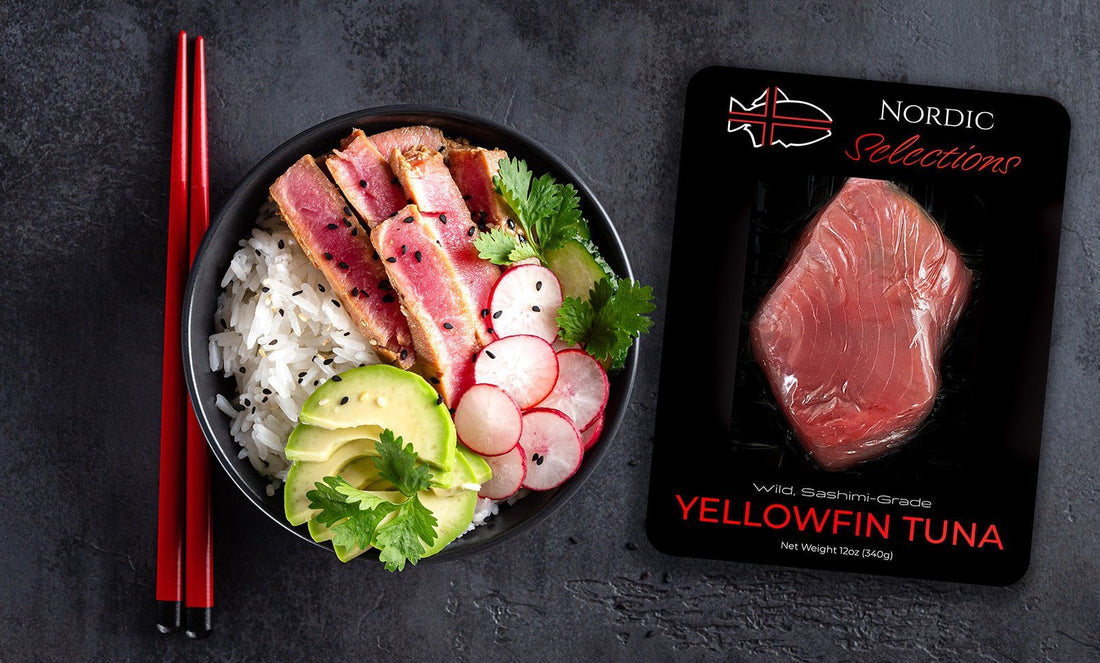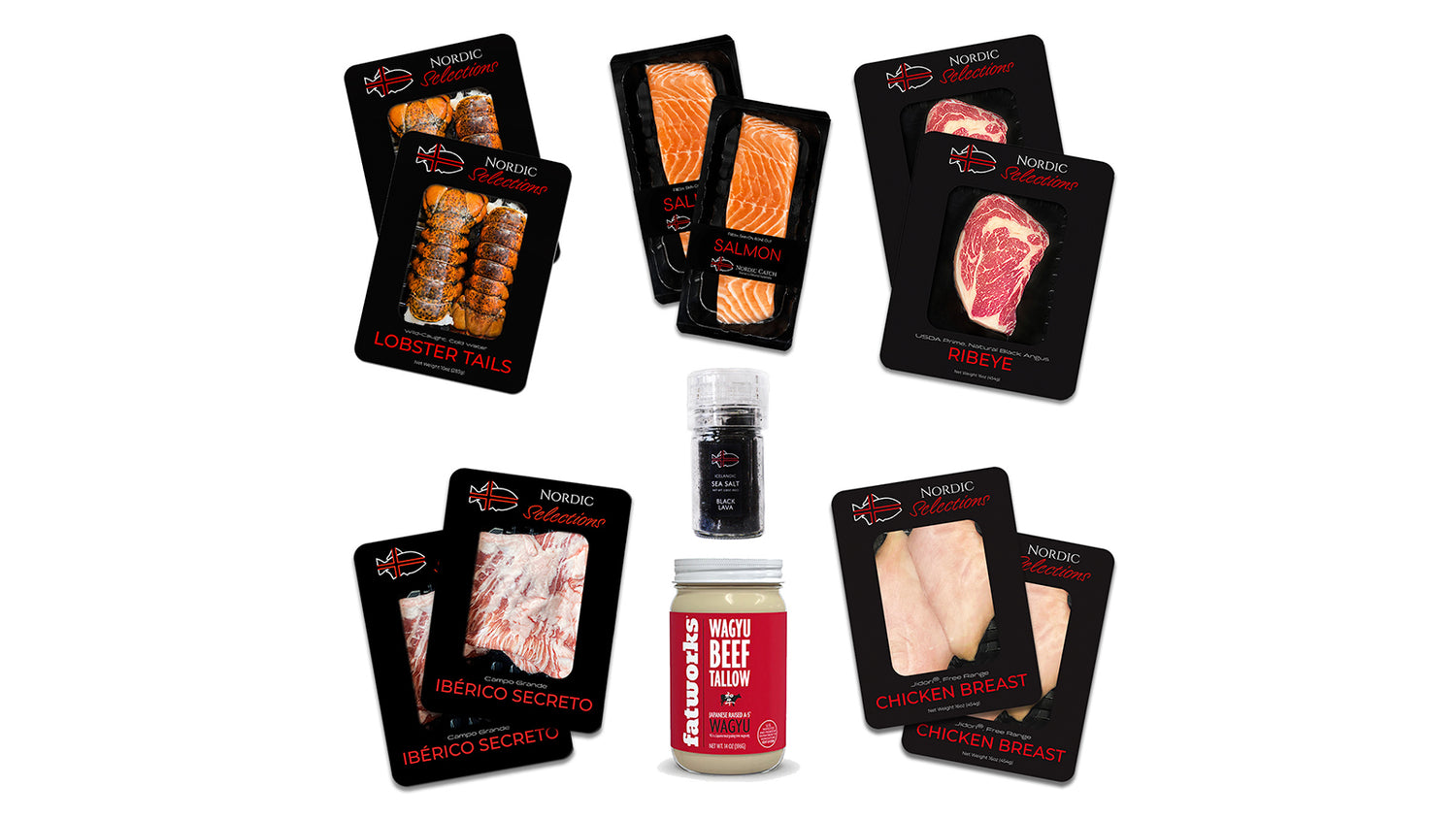
Highest Protein Seafood and Fish Options
Protein is essential to any balanced diet, and seafood is one of the best protein sources. It provides high-quality protein, and many seafood choices are rich in omega-3 fatty acids, vitamins, and minerals.
Whether you're looking to build muscle, recover after workouts, or maintain your overall health, the highest-protein seafood can be a powerful addition to your diet. When you're ready to stock up, buy bulk seafood for a convenient and cost-effective way to keep your diet on track.
Why Protein Matters in Your Diet
Protein is vital for your body's everyday functions, supporting muscle growth, tissue repair, and immune health. Including high-protein kinds of seafood like fish, sushi-grade salmon, and shellfish in your diet helps:
- Boost satiety: Protein-rich meals keep you full longer, reducing the likelihood of overeating.
- Build and maintain muscle: Adequate protein intake is crucial for muscle growth, especially when a healthy diet combines strength training.
- Support metabolism: Eating protein can increase your metabolic rate slightly as your body works to digest it. This has the potential to aid weight management.
- Strengthen bones: Protein intake reduces osteoporosis risk and improves bone density.
Top 10 High-Protein Seafoods and Fish Options
If you want to incorporate more protein into your diet, here are ten (10) types of nutrient-rich fish and seafood.
1. Tuna
Fresh tuna offers a robust 30.7g of protein per 100g serving, and canned tuna provides around 25.5g per 100g. Tuna is packed with B vitamins, selenium, and a range of essential nutrients supporting energy metabolism, immunity, and heart health. The high protein and low-fat profile make tuna steaks perfect for helping you build muscle and maintain lean mass.
Fresh tuna is incredibly versatile; try it grilled, seared, or raw in sushi and poke bowls. Canned tuna is convenient in sandwiches, wraps, salads, or pasta dishes. For added convenience, consider using a fresh seafood delivery service to ensure you get the best quality tuna right to your door.
2. Salmon
Wild-caught Alaskan salmon delivers about 26g of protein per 100g, while Atlantic salmon has around 25g per 100g. If you compare Alaskan vs. Atlantic salmon, It is the better choice due to its cleaner environment, higher nutritional value, and sustainability. Salmon is one of the healthiest types of seafood and stands out for its high omega-3 content, which promotes heart, brain, and joint health. It also provides a solid dose of vitamin D, B vitamins, potassium, and selenium, supporting your immunity, bone health, and energy.
There are many ways to cook salmon. Grill, bake, or pan-sear salmon for a quick and flavorful meal. Its rich taste pairs well with citrus or herb seasonings. Salmon is also delicious smoked or poached for a lighter preparation. For a balanced, nutrient-packed dish, try serving it with whole grains and roasted vegetables. And as with most seafood, fresh fish is better than frozen fish.
3. Cod
Cod delivers a lean 23g of protein per 100g, making it an excellent high-protein choice for lighter meals. There are different types of cod. Wild Icelandic cod contains approximately 90 calories, 19 grams of protein, and less than 1 gram of fat. Pacific cod is similar, with about 85 calories and 20 grams of protein. Cod is low in calories and fat, making it one of the best seafoods for weight management. It's also rich in B vitamins and selenium, which support your immune health, energy production, and antioxidant defenses.
Cod's mild flavor and firm texture make bake, broil, or sauté easy. To enhance its delicate taste, add spices or a squeeze of lemon. Cod also works well in fish tacos, soups, or as part of a hearty fish stew for a protein-packed meal.
4. Shrimp
Shrimp packs about 20g of protein per 100g and is very low in calories, making it a lean protein powerhouse. Low in fat and high in essential nutrients like selenium and iodine, shrimp supports your thyroid health, immunity, and overall energy levels. Its high protein content helps with muscle repair and maintenance.
Shrimp's mild taste and quick cooking time make it perfect for grilling, sautéing, or boiling. Add shrimp to salads, pasta dishes, stir-fries, or tacos. Its flavor pairs well with garlic, herbs, and various sauces, making it versatile for many dishes. Use a shrimp sizing guide to determine the right size for your dish. Giant shrimp, like jumbo or colossal, are perfect for grilling or incorporating into main dishes, while smaller shrimp are great for pasta, salads, or appetizers.
5. Halibut
Halibut provides around 22g of protein per 100g serving, making it a substantial source of protein. Halibut is low in fat yet rich in essential nutrients like magnesium and phosphorus, which support bone and heart health. Its high protein content aids with muscle recovery and growth.
Halibut's firm, meaty texture makes it ideal for grilling, baking, or pan-searing. Try poaching or steaming the halibut for a lighter dish to preserve its moisture and delicate flavor. Serve the fish with steamed vegetables or a fresh salad to round out a nutritious meal.
6. Scallops
Scallops deliver around 24g of protein per 100g serving, making them an impressive high-protein seafood choice. Scallops are low in fat and calories but high in protein and minerals like magnesium and potassium. These nutrients support your heart health, nerve function, and muscle recovery.
Sear or grill scallops to bring out their natural sweetness. Scallops cook quickly, making them ideal for fast, protein-rich meals. Serve them with a simple side of steamed vegetables or a fresh salad for a light, nutritious dish.
7. Mackerel
Mackerel contains about 21g of protein per 100g serving. As an oily fish, mackerel is loaded with omega-3 fatty acids, vitamin D, and B12. These nutrients support your heart, brain, and immune health, benefiting your skin and hair.
Mackerel's rich, bold flavor shines when you grill, bake, or smoke it. The fish pairs well with robust seasonings like garlic, rosemary, or a squeeze of lemon. Try mackerel with whole grains or mixed greens to balance its pungent taste and create a well-rounded meal.
8. Swordfish
Swordfish provides approximately 23g of protein per 100g serving. Known for its meaty texture, swordfish is rich in B vitamins, magnesium, and zinc. These nutrients contribute to the body's ability to produce energy and keep muscles functioning properly. This fish is an excellent choice for a filling, high-protein meal.
Swordfish is ideal for grilling or baking because its dense texture holds up well during cooking. Marinades or rubs can enhance the fish's mild flavor. Pair it with steamed vegetables or roasted potatoes for a satisfying, protein-rich meal.
9. Crab
Crab meat contains about 17g of protein per 100g serving, offering a flavorful way to add protein to your diet. Crab is low in calories and fat while rich in B vitamins, zinc, and copper, which support immune health, metabolism, and nerve function.
Boil or steam crab legs to keep their flavor intact, or use crab meat in salads, sandwiches, or pasta. Crab cakes also make a delicious protein-rich main course or appetizer—crab's delicate flavor pairs well with lemon, herbs, and light sauces.
10. Sardines
Sardines pack an astounding 28g of protein per 100g serving. Incredibly nutrient-dense, these fish contain omega-3 fatty acids, vitamin D, and calcium (especially when consumed with their bones). These nutrients promote heart health and bone strength.
Enjoy sardines straight from the can as a quick snack; add them to salads or pasta or put them on whole-grain crackers for a light, protein-packed meal. Their intense flavor pairs well with bold seasonings, such as garlic or lemon, making them a budget-friendly addition to any meal.
Meal Ideas for High-Protein Seafood
Here are some tasty ways to incorporate high-protein seafood into your diet:
- Grilled tuna steak: Serve the fish with roasted vegetables for a balanced meal.
- Shrimp stir-fry: Combine the shrimp with mixed vegetables and brown rice for a high-protein, low-calorie dish.
- Salmon salad: Top mixed greens with grilled salmon, cherry tomatoes, and a vinaigrette dressing.
- Cod fish tacos: Use grilled or baked cod in whole-grain tortillas with cabbage slaw.
- Sardine pasta: Add sardines to whole wheat pasta with garlic, olive oil, and a squeeze of lemon.
To retain the nutritional benefits of your seafood, choose high-quality, fresh, or adequately frozen seafood, and opt for healthy cooking methods like grilling, baking, or steaming to preserve the nutrients and flavor. Boost a fish's flavor naturally using herbs, lemon juice, or garlic instead of heavy sauces. Lastly, avoid overcooking seafood, which can become rigid and lose nutritional value.
Protein Comparison of Widely Consumed Seafoods
|
Seafood |
Protein (g) |
Calories (per 3 oz. serving) |
|
Tuna (Yellowfin) |
30 |
139 |
|
Tilapia |
26.3 |
128 |
|
Sardine |
23.4 |
177 |
|
Mackerel |
23.8 |
232 |
|
Swordfish |
23 |
140 |
|
Cod |
22.8 |
105 |
|
Salmon |
22.1 |
206 |
|
Shrimp |
20.9 |
99 |
|
Halibut |
20.6 |
122 |
|
Crab |
19 |
85 |
Source: USDA FoodData Central
Frequently Asked Questions
Which seafood is highest in protein?
Tuna and cod are among the highest in protein, with tuna providing around 30 grams of protein per 3-ounce serving.
What seafood is the healthiest?
Wild-caught salmon, particularly Alaskan salmon, is considered one of the healthiest seafood options due to its high omega-3 content and low levels of contaminants.
What seafood is best for lean protein?
Cod and halibut are among the best seafood choices for lean protein, providing high protein with lower fat content.
What makes seafood a good source of protein?
Seafood offers high-quality, complete protein with all the essential amino acids, low saturated fat, and additional nutrients like omega-3 fatty acids, making it a nutritious protein source.
How much protein do I need daily?
The average adult needs 0.36g of protein per pound of body weight (or 0.8g of protein per kg of body weight) daily. However, active individuals or those with higher muscle mass may require more.

